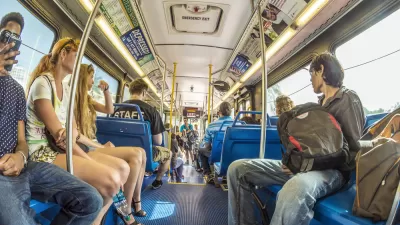Many commuters still find buses, trains, and subways to be more cost-effective than driving. However, mass transit funds are drying up, and increased fees and decreased service may deter riders from sticking to mass transit.
"The American Public Transportation Assn., which lobbies on behalf of local transit agencies in Washington, is hoping Congress will add another $2.5 billion for operating expenses to the stimulus bill, which could go to the House floor as early as next week.
'Today, transit systems of all sizes are cutting service and planning immediate employee layoffs,' wrote William W. Millar, the APTA president, in a letter to House Speaker Nancy Pelosi on Jan. 16. 'Public transportation services should not be cut when the United States is attempting to reduce its levels of energy consumption.'
In addition to skepticism about the stimulus strategy in general, the idea of using the stimulus money to fund operating costs may be a particularly hard sell politically.
Ronald D. Utt, a research fellow at the conservative Heritage Foundation, said such spending was essentially a way to avoid subsidizing fares for transit riders. 'That's really not consistent with the purpose of the stimulus plan, which is to create jobs,' he said.
Proponents argue that operating subsidies would help the economy by preempting transit layoffs. But some concede that it would only temporarily address the core problem – which is the decline in local tax collections."
FULL STORY: A mass transit dilemma: Ridership up, funds down

Alabama: Trump Terminates Settlements for Black Communities Harmed By Raw Sewage
Trump deemed the landmark civil rights agreement “illegal DEI and environmental justice policy.”

Planetizen Federal Action Tracker
A weekly monitor of how Trump’s orders and actions are impacting planners and planning in America.

The 120 Year Old Tiny Home Villages That Sheltered San Francisco’s Earthquake Refugees
More than a century ago, San Francisco mobilized to house thousands of residents displaced by the 1906 earthquake. Could their strategy offer a model for the present?

In Both Crashes and Crime, Public Transportation is Far Safer than Driving
Contrary to popular assumptions, public transportation has far lower crash and crime rates than automobile travel. For safer communities, improve and encourage transit travel.

Report: Zoning Reforms Should Complement Nashville’s Ambitious Transit Plan
Without reform, restrictive zoning codes will limit the impact of the city’s planned transit expansion and could exclude some of the residents who depend on transit the most.

Judge Orders Release of Frozen IRA, IIJA Funding
The decision is a victory for environmental groups who charged that freezing funds for critical infrastructure and disaster response programs caused “real and irreparable harm” to communities.
Urban Design for Planners 1: Software Tools
This six-course series explores essential urban design concepts using open source software and equips planners with the tools they need to participate fully in the urban design process.
Planning for Universal Design
Learn the tools for implementing Universal Design in planning regulations.
Clanton & Associates, Inc.
Jessamine County Fiscal Court
Institute for Housing and Urban Development Studies (IHS)
City of Grandview
Harvard GSD Executive Education
Toledo-Lucas County Plan Commissions
Salt Lake City
NYU Wagner Graduate School of Public Service





























